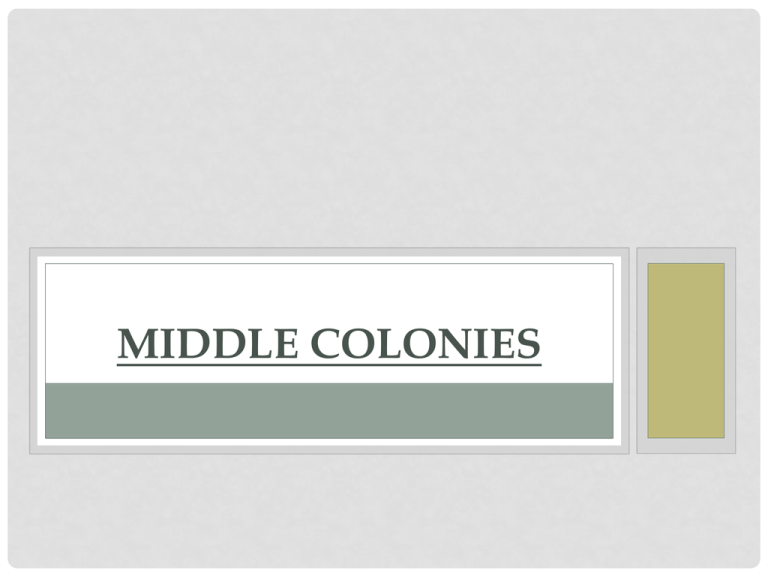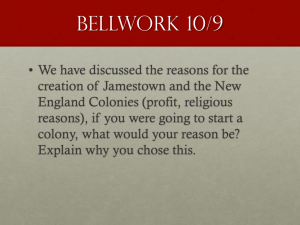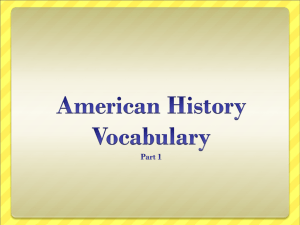3.3 and 3.4 Middle and Southern Colonies
advertisement

MIDDLE COLONIES NEW YORK • Proprietary Colony: Colony in which the owner, or proprietor, owns all the land and controls the government • Taken from the Netherlands (Dutch) • Diverse population of Dutch, German, Swedish, and Native Americans • 1664: 8,000 inhabitants • 1683: 12,000 inhabitants NEW JERSEY • The Duke of York gave the southern part of New York to two proprietors • This southern part of New York becomes New Jersey • To attract settlers, they offer large tracts of land and religious freedom • New Jersey had ethnic and religious diversity • New Jersey had no natural harbors • Problems? • Few Profits • 1702: New Jersey becomes a royal colony PENNSYLVANIA • 1681: King Charles II gives William Penn land as a payment for a debt owed to Penn’s father • Colony was named Pennsylvania • Quakers • Equality • Follow own “inner light” to salvation • Pacifists: People who refuse to use force or fight • William Penn designed Philadelphia • Penn negotiated with Native Americans • Paid them for land • Created several treaties • 1701: Charter of Liberties • Granted colonists the right to elect representatives DELAWARE • Swedes had settled in southern Pennsylvania before the English took over • Charter of Privileges • Allowed these counties to form their own legislature • Delaware is formed as a separate colony under Pennsylvania’s governor SOUTHERN COLONIES • White Males control most property • Plantations • Important for economic growth of the Southern colonies • As the number of plantations grow the need for workers increased • Workers included: English criminals, prisoners of war, African slaves, and indentured servants • Indentured Servants: Agreed to work without pay for a certain length of time to pay off a debt MARYLAND • George Calvert, Lord Baltimore • Son Celcilius will inherit colony • Safe Haven for Catholics • Proprietary Colony • Estates: Pieces of land • Given to English aristocrats • Maryland relied on indentured servants and enslaved Africans to work on plantations MASON-DIXON LINE • 1760s • Pennyslvania and Maryland argued over the boundary between the states • Mason-Dixon Line: Created to end the dispute between Pennslyvania and Maryland by setting their boundary CAROLINA • • • • 1663 “Charles’ Land” Proprietary Colony John Locke created a Constitution for the colony • Constitution: Plan of government • Split into North and South Carolina • North Carolina • Grew Tobacco, sold timber and tar • Lacked a good harbor • South Carolina • Fertile farmland • Charles Town • Deerskin, lumber, and beef • Rice and Indigo became chief crops GEORGIA • 1733 • James Olgethorpe • Colony was set up for debtors and poor people to make a fresh start • Debtors: Not able to repay debts • British hoped that Georgia would protect the colonies from Spain • Georgia is returned to the crown in 1751 • Poor people, religious refugees, and some Jews settled in Georgia NEW ENGLAND • Subsistence Farming: Farmers produce enough to meet their own families’ needs, with little left over to sell • Farming is the main economic activity of all the colonies • Northern farmers relied on their children for labor • Spinning yarn, preserving fruit, milking cows, fencing fields, harvesting OTHER INDUSTRIES • New England • Mills • Women made cloth, candles, soap • Skilled craftspeople • Shipbuilding • Lumber for building ships came from nearby forests • New England is the center of colonial trade MIDDLE COLONIES • Cash Crops: Farm crop raised to be sold for money • Industries • Carpentry • Flour making • Lumbering, mining, and manufacturing SOUTHERN COLONIES • Most settlers in the South made their living from farming • Principal Cash Crops • Tobaccco- Maryland and Virginia • Rice- South Carolina and Georgia • Tobacco is sold in Europe • Slave Code: Strict rules that governed the behavior and punishment of enslaved Africans • Slaves could not learn to read or write • Slaves could not leave without their owner’s permission • The majority of white Southerners were NOT slaveholders! TRIANGULAR TRADE • North America to England: Rice, Tobacco, Indigo, Furs • England to Africa: Cloth, Manufactured goods • Africa to Americas: Slaves, Gold, Pepper • Middle Passage: Part of the Triangular Trade where enslaved Africans are shipped to the West Indies • Terrible conditions • Spent more than a month chained together in tight spaces • Approximately 12 million Africans



